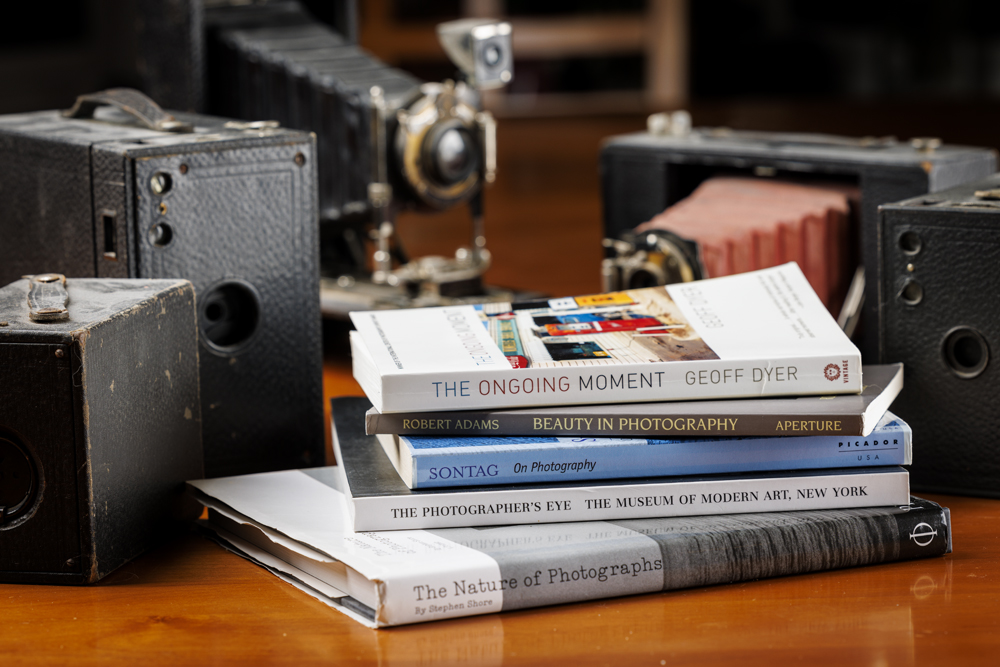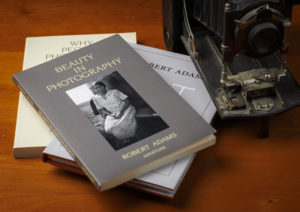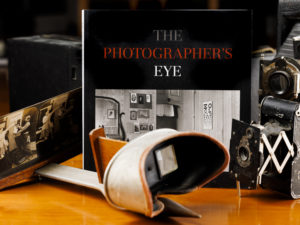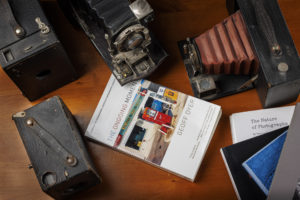Books for Thinking Photographers
I pity anyone who has to buy presents for a photographer.
Photography is an expensive hobby and the more serious the photographer, the more expensive our desires. Worse yet, most photographers are terribly picky. We have specific desires that are known only to ourselves and we do a poor job of defining what those are.
To make matters worse, we speak a language that only other photographers can understand.
Well, that’s not really true. Visit any photography forum on the internet and you will see photographers arguing endlessly over terms that even we don’t understand.
About the only surefire method is to simply have us hand you a list or send a link and say, “this is what I want, and only this. Don’t even think about being creative or freelancing, as I will be disappointed and you will have wasted your money.”
But, unless you are wealthy, that is fraught with danger because (trust me on this) what he or she really wants will set you back about as much as the down payment on your home.
Still Christmas is bearing down on us and some of you will feel an irresistible desire to buy your photographer a gift that he or she will actually appreciate – even if they don’t know they will.
The List
With that in mind, I am offering up a short list of books and authors that your photographer ought to love if he or she has an ounce of sense. Of course, there is always the risk that your photographer lacks that ounce. In which case, this list won’t help you.
But, you will have tried. And at a minimum, you will know that it isn’t your fault that your photographer is an ignorant oaf that doesn’t deserve a decent gift anyway.
These are all affordable, enjoyable and timeless books. They will help the photographer on your list appreciate photography as an art form that offers a lifetime of challenges and growth. A disclaimer, with the exception of one author, this is not a list of “how to” books or the sort of inspirational “follow your dream” self-help genre that floods the market. Too many of those books are just junk food filled with empty intellectual calories.
I am going for the kind of books that get the reader thinking about photography in ways that they may never have thought of photography before.
Most of these books are relatively short. A few can be read in a day, but all deserve leisurely, thoughtful consideration to really appreciate them. Some can be enjoyed over and over again. I have organized the books by author and selected just five authors.
It takes only a sentence or two to see that Robert Adams began his career as a college English teacher. His writing is rich and poetic and it would be worth reading his essays simply to enjoy the writing. But, Adams has a lot to say and his work will challenge and reward any photographer who cares about photography.
For this list I recommend any of three books – Beauty in Photography, Why People Photograph and Art Can Help. Together, these three books span more than forty years of essays.
Adams reveals where he is coming from in his subtitle to Beauty in Photography, which is “Essays in defense of traditional values.” The traditional values that Adams refers to are not societal values, but rather the value that beauty plays as an essential component of art.
But Adams is not defending the cliched “beauty” that pollutes the pages of so many popular photography magazines, websites and photo sharing platforms. Or, as Adams writes, “the ten thousandth camera-club imitation of a picture by Ansel Adams.”
To Adams, “for a picture to be beautiful…it must in some significant respect be unlike what has preceded it.”
Now, that’s a challenge for any photographer who hopes to create something truly beautiful. Most of us will never achieve that, but isn’t it a worthwhile goal to reach for?
Stephen Shore called The Nature of Photographs a primer. Don’t be fooled by the term. While this book is certainly appropriate for beginning photographers, it offers lessons that will benefit anyone, no matter how experienced.
Drawing on images across the history of photography, including some of his own, Shore explores the essential qualities of photographs. He begins the book with a brief discussion of the nature of photographs and then looks at three main subject areas: The Physical Level, The Depictive Level and The Mental Level. He then concludes by pulling the elements together in a final section on Mental Modelling.
Shore does not waste words. The commentaries that accompany each image are deceptively brief and encourage the reader to soak in the images themselves. Shore intermingles obscure and even anonymous images with iconic photographs from some of the most respected photographers of the 20th century.
Shore’s technique serves a dual purpose. He has offered up a primer on the nature of photography. But, at the same time he is whetting the reader’s appetite to explore the history and breadth of photography as a medium of creative expression.
John Szarkowski was Director of the Department of Photography at the Museum of Modern Art and in Looking at Photographs, he pulled 100 pictures from the collection and offered brief commentaries on each.
If you have ever been mystified as to why some pictures are considered masterpieces and why some photographers find their way into museums while others do not, Szarkowski’s commentaries may not provide complete answers, but they do give us a better idea of the thought process of one of the 20th centuries most influential curators.
Szarkowski’s The Photographer’s Eye (Not to be confused with an identically titled how-to book by Michael Freeman) might fairly be called a companion volume to Shore’s The Nature of Photographs, although about 40 years separate the two books. Like Shore, Szarkowski kept the text to a minimum, conveying key concepts in just a few paragraphs and letting most of the photographs do the talking.
Both books explore the physical attributes of photographs and why those physical attributes make photography a unique art form. It is an art that, in his introduction, Szarkowski famously wrote: The history of photography has been less a journey than a growth…Like an organism, photography was born whole. It is in our progressive discovery of it that its history lies.”
I am about waste deep in Geoff Dyer’s See/Saw, so I will defer any review, other than to say I am nearly as pleased with it as I was with Dyer’s first book on photography, The Ongoing Moment.
Dyer is a writer of both fiction and nonfiction and the author of nearly 20 books covering everything from jazz to yoga to life aboard the U.S.S. George H. W. Bush. What I most appreciate about Dyer is that, although he is clearly an intellectual, there is not a hint of snobbery in his writing. Dyer may casually make references to authors and literary themes that could easily be the stuff of a cocktail party among English department PhDs, but his writing makes you feel like you are sitting across from him in a corner pub and, if he isn’t quite the most fascinating man in the world, he is a close second.
The basic idea of The Ongoing Moment is an exploration of common themes and subjects that have appeared and reappeared across the history of photography in the works of widely divergent artists. But that doesn’t really do justice to the book, because what it really comes down to is an amusing, fascinating and enlightening trip through photography’s past uncovering details in the lives of great photographers that turn out to be precious gems.
Next year it will be 50 years since Susan Sontag’s On Photography was published. In the ensuing years the technology of photography has undergone massive changes. Who today even remembers the little huts doting parking lots across the country that used to personify amateur photography – the drive up cubicles where you could drop off your Instamatic cassettes and come back the next day for a packet of prints?
Yet, Sontag’s critiques of photography have hardly aged over a half a century. As we sit here on the other side of the digital revolution that changed photography forever, most of what she wrote is as relevant today as it was when her book was published. Much of it is even more relevant.
Sontag recognized trends that were emerging in the 1960s and 70s, but which have now become thoroughly entrenched in the museum world. From the vantage point of 2022, her critique of where photography was headed was remarkably prescient.
Sontag was a fierce critic. The one by the side of the road willing to declare that the emperor had no clothes. But if she was harsh it was because she cared deeply about photography. Her book is short – just over 200 pages – and divided into seven brief sections, including a final section comprised solely of quotations on photography. Few authors have packed so much in so few pages as Sontag.
Sontag died in 2004, three years before the first iPhone. Her death deprived all of us of the opportunity to know what one of the great critiques would have said about the social photo.
As promised, I have a recommendation for anyone who feels they absolutely must give their photographer a how-to book.
Scott Kelby has built an empire by writing, hosting workshops and producing videos, mainly on Adobe’s Photoshop and Lightroom Classic.
Every few years he releases separate books that are reasonably comprehensive guidebooks on both subjects. He also produces a number of books that cover more limited or specific topics related to either Photoshop and/or Lightroom.
When shopping, try to make sure you are buying the most recent versions of the books on Photoshop or Lightroom (Whichever program your photographer uses).
Each time a new edition comes around, I tell myself I don’t really need it and then, a few months later it is on my bookshelf.
Kelby’s books are not really complete guides to Photoshop or Lightroom, but rather they offer specific tips and techniques for each program. Photographers will get the most benefit from the books if they have a bit of working knowledge of the programs, but Adobe’s online documentation and tutorials are so good that that should not be a problem for most photographers.
As the functionality of Lightroom and Photoshop’s Camera Raw processing functions have converged, so has much of the advice given in the two versions of Kelby’s books so just buy the one that corresponds to the program your photographer uses.
I have the Photoshop books going back to 2007 and keep them all within reach because with each new edition, some of the past tips disappear and are replaced by new ones. It is an understatement to say that Kelby’s writing style is informal. If you enjoy that sort of corn, you will love his writing. If you don’t, then simply try to look past it for the very valuable advice he offers.
Part II: Affordable Portfolio Series for Photographers






